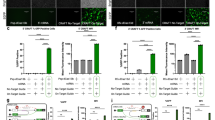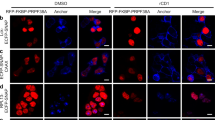Abstract
In mammalian cells, genetic instructions are usually revised by RNA splicing before they are translated to proteins. Here we demonstrate that a trans–splicing group I ribozyme can be employed to intentionally modify the sequence of targeted transcripts in tissue culture cells. By analyzing the ribozyme reaction products, we demonstrate that targeted trans–splicing can proceed in murine fibroblasts with high fidelity, providing direct evidence that ribozymes function as anticipated in a therapeutically relevant setting. Tram–splicing is not very specific however, and the ribozyme reacted with and tagged a variety of cellular transcripts with its 3′ exon sequence. RNA tagging provides a unique approach to study RNA catalysis in mammalian cells. Such analysis should facilitate the logical development of safe, therapeutic ribozymes that can repair mutant RNAs associated with a variety of inherited diseases.
This is a preview of subscription content, access via your institution
Access options
Subscribe to this journal
Receive 12 print issues and online access
$209.00 per year
only $17.42 per issue
Buy this article
- Purchase on Springer Link
- Instant access to full article PDF
Prices may be subject to local taxes which are calculated during checkout
Similar content being viewed by others
References
Cech, T.R. Self-splicing of group I introns. Annu. Rev. Biochem. 59, 543–568 (1990).
Zaug, A.J., Been, M.D. & Cech, T.R. The Tetrahymena ribozyme acts like an RNA restriction endonuclease. Nature 324, 429–433 (1986).
Uhlenbeck, O.C. A small catalytic oligoribonucleotide. Nature 328, 596–600 (1987).
Haseloff, J. & Gerlach, W.L. Simple RNA enzymes with new and highly specific endoribonuclease activities. Nature 334, 585–591 (1988).
Feldstein, P.A., Buzayan, J.M. & Bruening, G. Two sequences participating in the autolytic processing of satellite tobacco ringspot virus complementary RNA. Gene 2, 53–61 (1989).
Hampel, A., Tritz, R., Hicks, M. & Cruz, P. ‘Hairpin’catalytic RNA model: Evidence for helices and sequence requirement for substrate RNA. Nucleic Acids Res. 18, 299–304 (1990).
Chowrira, B.M. & Burke, J.M. Binding and cleavage of nucleic acids by the hairpin ribozyme. Biochemistry 30, 8518–8522 (1991).
Forester, A.C. & Altman, S. External guide sequence for an RNA enzyme. Science 249, 783–786 (1990).
Perrotta, A.T. & Been, M.D. Cleavage of oligoribonucleotides by a ribozyme derived from the hepatitis delta virus RNA sequence. Biochemistry 31, 16–21 (1992).
Sullenger, B.A. & Cech, T.R. Ribozyme-mediated repair of defective mRNA by targeted trans-splicing. Nature 371, 619–622 (1994).
Cech, T.R. Ribozymes and their medical implications. J. Am. Med. Assoc. 260, 3030–3034 (1988).
Rossi, J.J. Ribozymes. Curr. Opin. Biotechnol. 3, 3–7 (1992).
Yu, M., Poeschla, E. & Wong-Staal, F. Progress towards gene therapy for HIV infection. Gene Ther. 1, 13–26 (1994).
Sullenger, B.A. Revising messages traveling along the cellular information superhighway. Chem. Biol. 2, 249–253 (1995).
Inoue, T., Sullivan, F.X. & Cech, T.R. Intermolecular exon ligation of the rRNA precursor of Tetrahymena: Oligonucleotides can function as 5′ exons. Cell 43, 431–437 (1985).
Been, M.D. & Cech, T.R. One binding site determines sequence specificity of Tetrahymena pre-rRNA self-splicing, trans-splicing, and RNA enzyme activity. Cell 47, 207–216 (1986).
Elroy-Stein, O. & Moss, B. Cytoplasmic expression system based on constitutive synthesis of bacteriophage T7 RNA polymerase in mammalian cells. Proc. Natl. Acad. Sci. USA 87, 6743–6747 (1990).
Zaug, A.J., Grosshans, C.A. & Cech, T.R. Sequence-specific endoribonuclease activity of the Tetrahymena ribozyme: Enhanced cleavage of certain oligonucleotide substrates that form mismatched ribozyme-substrate complexes. Biochemistry 27, 8924–8931 (1988).
Yams, M. A specific amino acid binding site composed of RNA. Science 240, 1751–1758 (1988).
Yarus, M. Specificity of arginine binding by the Tetrahymena intron. Biochemistry 28, 980–995 (1989).
Frohman, M.A. RACE: Rapid amplification of cDNA ends. in PCR Protocols: A Guide to Methods and Applications (eds.Innis, M.A., Gelfand, D.H., Sninsky, J J. & White, T.J.) 28–38 (Academic Press, San Diego, 1990).
Hantzopoulos, P.A., Sullenger, B.A., Ungers, G. & Gilboa, E. Improved gene expression upon transfer of the adenosine deaminase minigene outside the transcription unit of a retroviral vector. Proc. Natl. Acad. Sci. USA 86, 3519–3523 (1989).
Kramer, A., Mulhauser, F., Wersig, C., Groning, K. & Bilbe, G. Mammalian splicing factor SF3al20 represents a new member of the SURP family of proteins and is homologous to the essential splicing factor PRP21p of S. cerevisiae. RNA 1, 260–272 (1995).
Young, B., Herschlag, D. & Cech, T.R. Mutations in a nonconserved sequence of the Tetrahymena ribozyme increase activity and specificity. Cell 67, 1007–1019 (1991).
Pyle, A.M., Murphy, F.L. & Cech, T.R. RNA substrate binding site in the catalytic core of the Tetrahymena ribozyme. Nature 358, 123–128 (1992).
Sullenger, B.A. & Cech, T.R. Tethering ribozymes to a retroviral packaging signal for destruction of viral RNA. Science 262, 1566–1569 (1993).
Feramisco, J.R., Smart, J.E., Burridge, K., Helfman, D.M. & Thomas, G.P. Co-existence of vinculin and a vinculin-like protein of higher molecular weight in smooth muscle. J. Biol. Chem. 257, 11024–11031 (1982).
Armatano, D. et al. Effect of internal viral sequences on the utility of retroviral vectors. J. Virol. 61, 1647–1650 (1987).
Cullen, B.R. Trans-activation of human immunodeficiency virus occurs via a bimodal mechanism. Cell 46, 973–982 (1986).
Simonsen, C.C. & Levinson, A.D. Isolation and expression of an altered mouse dihydrofolate reductase cDNA. Proc. Natl. Acad. Sci. USA 80, 2495–2499 (1983).
Sullenger, B.A., Lee, T.C., Smith, C.A., Ungers, G.E. & Gilboa, E. Expression of chimeric tRNA-driven antisense transcripts renders N1H 3T3 cells highly resistant to Moloney murine leukemia virus replication. Mol. Cell. Biol. 10, 6512–6523 (1990).
Murphy, F.L. & Cech, T.R. Alteration of substrate specificity for the endoribonucleolytic cleavage of RNA by the Tetrahymena ribozyme. Proc. Natl. Acad. Sci. USA 86, 9218–9222 (1989).
Author information
Authors and Affiliations
Rights and permissions
About this article
Cite this article
Jones, J., Lee, SW. & Sullenger, B. Tagging ribozyme reaction sites to follow trans–splicing in mammalian cells. Nat Med 2, 643–648 (1996). https://doi.org/10.1038/nm0696-643
Received:
Accepted:
Issue Date:
DOI: https://doi.org/10.1038/nm0696-643
This article is cited by
-
Targeted Regression of Hepatocellular Carcinoma by Cancer-Specific RNA Replacement through MicroRNA Regulation
Scientific Reports (2015)
-
Validation of tissue-specific promoter-driven tumor-targeting trans-splicing ribozyme system as a multifunctional cancer gene therapy device in vivo
Cancer Gene Therapy (2009)
-
In Vivo Reprogramming of hTERT by Trans-splicing Ribozyme to Target Tumor Cells
Molecular Therapy (2008)
-
Molecular therapy and prevention of liver diseases
Virologica Sinica (2008)
-
Emerging clinical applications of RNA
Nature (2002)



